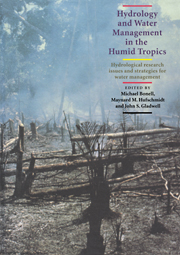 Hydrology and Water Management in the Humid Tropics
Hydrology and Water Management in the Humid Tropics Book contents
- Frontmatter
- Contents
- List of Authors
- Foreword by Federico Mayor, Director-General, UNESCO
- Preface
- Cartographic Credit
- Acknowledgements
- SECTION I INTRODUCTION
- SECTION II HUMID TROPICS SETTING
- SECTION III REGIONAL HYDROLOGY
- 5 Hydrology in Humid Tropical Asia
- 6 The Hydrology and Water Resources of Humid Northern Australia and Papua New Guinea
- 7 Hydrology and Water Resources of Tropical Latin America and the Caribbean
- 8 Amazonia Rainfall and Its Variability
- 9 Regional Hydrology and Water Resources in the African Humid Tropics
- 10 Review of Hydrology and Water Resources of Humid Tropical Islands
- SECTION IV PHYSICAL PROCESSES
- SECTION V PHYSICAL PROCESSES – HUMAN USES: THE INTERFACE
- SECTION VI MANAGEMENT ISSUES
- SECTION VII APPENDICES
- Place index
10 - Review of Hydrology and Water Resources of Humid Tropical Islands
Published online by Cambridge University Press: 23 December 2009
- Frontmatter
- Contents
- List of Authors
- Foreword by Federico Mayor, Director-General, UNESCO
- Preface
- Cartographic Credit
- Acknowledgements
- SECTION I INTRODUCTION
- SECTION II HUMID TROPICS SETTING
- SECTION III REGIONAL HYDROLOGY
- 5 Hydrology in Humid Tropical Asia
- 6 The Hydrology and Water Resources of Humid Northern Australia and Papua New Guinea
- 7 Hydrology and Water Resources of Tropical Latin America and the Caribbean
- 8 Amazonia Rainfall and Its Variability
- 9 Regional Hydrology and Water Resources in the African Humid Tropics
- 10 Review of Hydrology and Water Resources of Humid Tropical Islands
- SECTION IV PHYSICAL PROCESSES
- SECTION V PHYSICAL PROCESSES – HUMAN USES: THE INTERFACE
- SECTION VI MANAGEMENT ISSUES
- SECTION VII APPENDICES
- Place index
Summary
ABSTRACT
There are many islands in the humid tropical regions of the world, most of which belong to developing nations. Islands, especially small oceanic islands, are unique in many ways. Island water resources are often very limited. Many have no surface water resources and rely on limited groundwater resources in the form of thin fresh water lenses. The exposure of islands makes them particularly vulnerable to cyclones, storm surges and droughts. This paper examines some of the major hydrological and water resources issues of small islands. The main topics discussed are fresh water occurrence, the water balance, water resource assessment, water use, and water resource development and management. Approaches to resolving some of the major problems are provided.
INTRODUCTION
Many islands in the world lie in the humid tropical region, defined as that region where the mean temperature of the coldest month is above 18°C and where the number of months with rainfall greater than 100 mm exceeds 4.5 (Chang & Lau, 1983). The land portion of many countries in the humid tropics consists entirely of islands. Examples of countries consisting of island archipelagos are Indonesia and the Philippines in South East Asia; the Cook Islands, Kiribati, the Federated States of Micronesia, Fiji, the Marshall Islands, New Guinea, Solomon Islands, Tokelau, Tonga, Tuvalu, Vanuatu and Western Samoa in the Pacific Ocean; the Maldives and Seychelles in the Indian Ocean and the Turks and Caicos and the Bahamas in the Caribbean Sea.
- Type
- Chapter
- Information
- Hydrology and Water Management in the Humid TropicsHydrological Research Issues and Strategies for Water Management, pp. 135 - 164Publisher: Cambridge University PressPrint publication year: 1993
- 13
- Cited by
